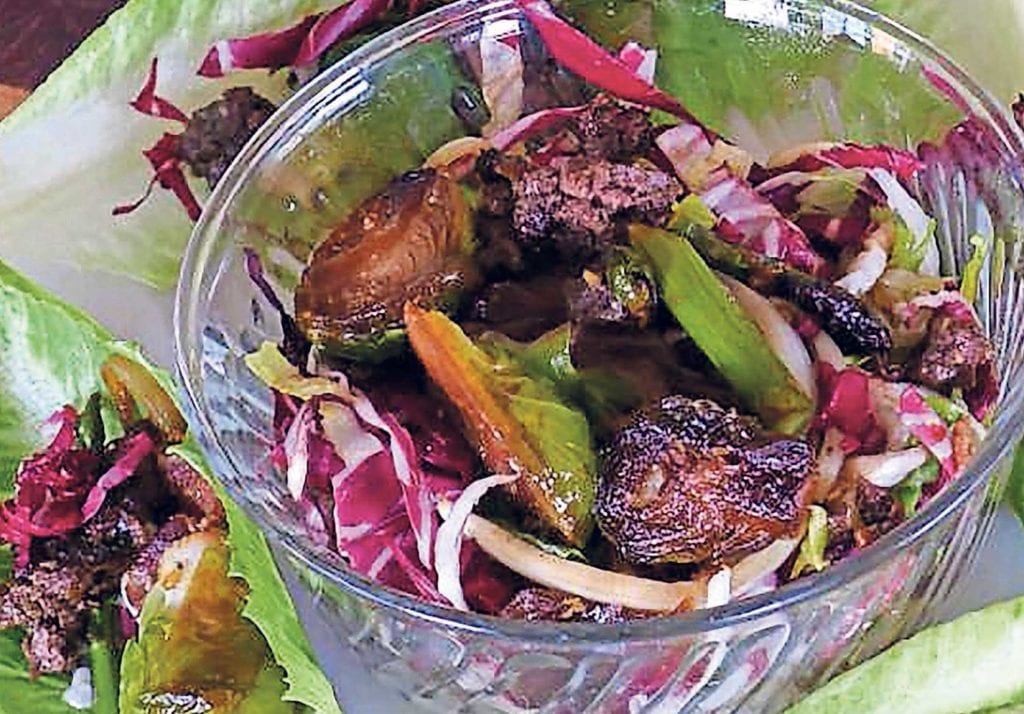
If you scan the tables of America’s favorite eateries, from foodie to fast-casual, you’ll witness many variations of a certain salad. A base of leaves, piled high with chicken, shrimp, cheese and croutons, as well as other foods that may or may not be raw, and may or may not be vegetables. One gets the feeling these over-garnished deli platters are aimed less at “real” salad eaters and more at people who have been told by their families, friends and doctors to eat salad. If one isn’t so into raw veggies, this allows one to eat salad by dipping a crouton into ranch dressing.
While it may seem like cheating, there is actually historical precedent for such decadent interpretations of salad. “Larousse Gastronomique” by Prosper Montagne, an authoritative encyclopedia of classic gastronomy published in 1938, defines salad as a dish “… made up of herbs, plants, vegetables, eggs, meat and fish.” You’d think Montagne wrote his book in a booth at the IHOP.
But there is an important caveat to his apparent condoning of busy salads. A good salad, Montagne writes, “… freshens without enfeebling and fortifies without irritating.” If freshened and fortified are how you want your body to feel, definitely consider raw vegetables.
With their fibers and vitamins, raw plant parts are the best things you can eat. I’m just gonna come out and say it: The problem is, they don’t fill you up. A good-sized salad will still leave your belly wanting more, unless the veggies are eclipsed by empty calories, or unless it’s followed by a serving of lasagna. If you eat enough leaves, of course, you will eventually get full. But the trick is to stay focused on the raw plant parts, and not the extra goodies that have been added to sweeten the deal.
The way to do this, I have found, is to make a dressing that is extra decadent, and omit the other bells and whistles.
Saucy Salad
- 1 softball-sized head of radicchio, sliced thin as if by deli machine. (Think coleslaw, but thinner.)
- Roughly the same amount of romaine lettuce, similarly cut (or use mostly romaine, if radicchio is too bitter for you)
- 1 medium-sized sweet or yellow onion, sliced in half and then into thin arcs
- 2 cloves garlic: pressed, grated or pounded
- Sliced cucumber, to taste
- ½ pound lean ground red meat (or alternative meat or protein)
- 12 Brussels sprouts, trimmed and sliced lengthwise (or other vegetable like asparagus)
- Olive oil (½ cup), soy sauce (¼ cup), cider vinegar (2 tablespoons)
Toss the radicchio and romaine with the vinegar, cucumber, half the garlic and half the sliced onions, and set in the fridge.
Pour the olive oil into a pan, and heat the meat, breaking it up into pieces with a spatula. Add the Brussels sprouts to the pan, cut sides down, and the rest of the onions on top. Cook slowly with the lid on, allowing the onions to give their moisture as the meat browns but doesn’t burn, and the Brussels sprouts soften. When the water is running low, add the soy sauce and the rest of the garlic, and stir.
What you have, at this point, is a lush sauce that could be poured over noodles or some other empty carb. If the veggies sucked up too much oil, add more to the pan, so the dressing is as greasy as it is meaty and salty. Let it cool for at least 10 minutes, then spoon it onto your salad.
Greasy Lettuce Boats
Another way to use that same chunky sauce on some leaves is to spoon small amounts of it into lettuce boats. They are an easy way to get kids to eat leaves, and can be busied up as much as the audience can handle. Baby romaine, or other small lettuce heads, are especially well-suited for this task. (With larger leaves, consider making rolls).
Deconstruct the lettuce, removing the leaves and filling them with greasy sauce and goodies. I begin with a dab of mayo (for me when I say mayo, I mean Grapeseed Oil Vegenaise). Shreds of radicchio or cabbage can be added to these boats as well, or pickle, for a splash of acid.






